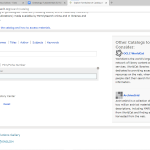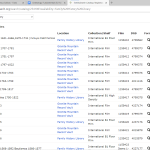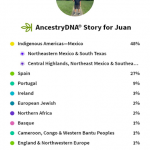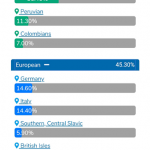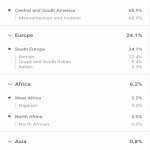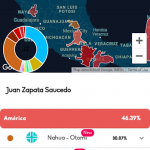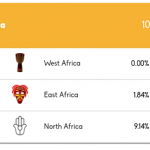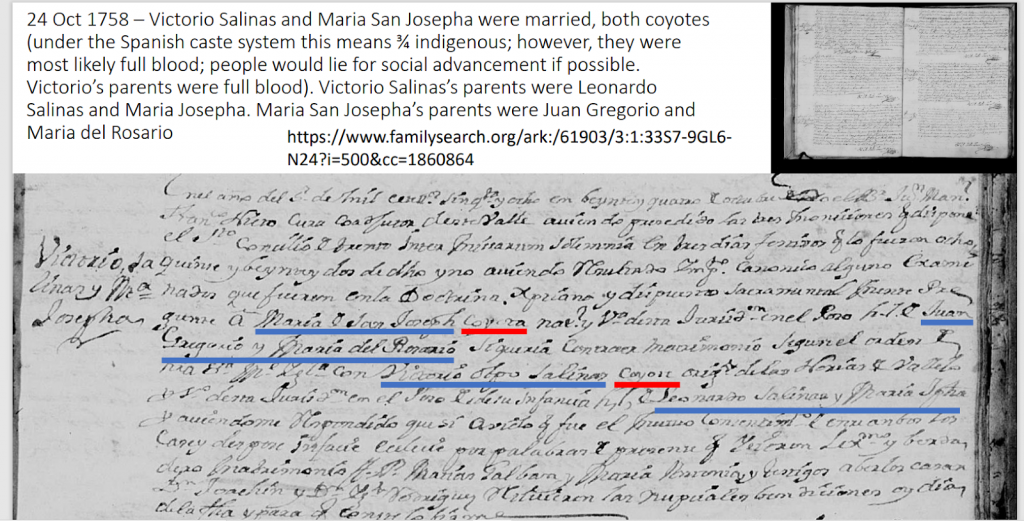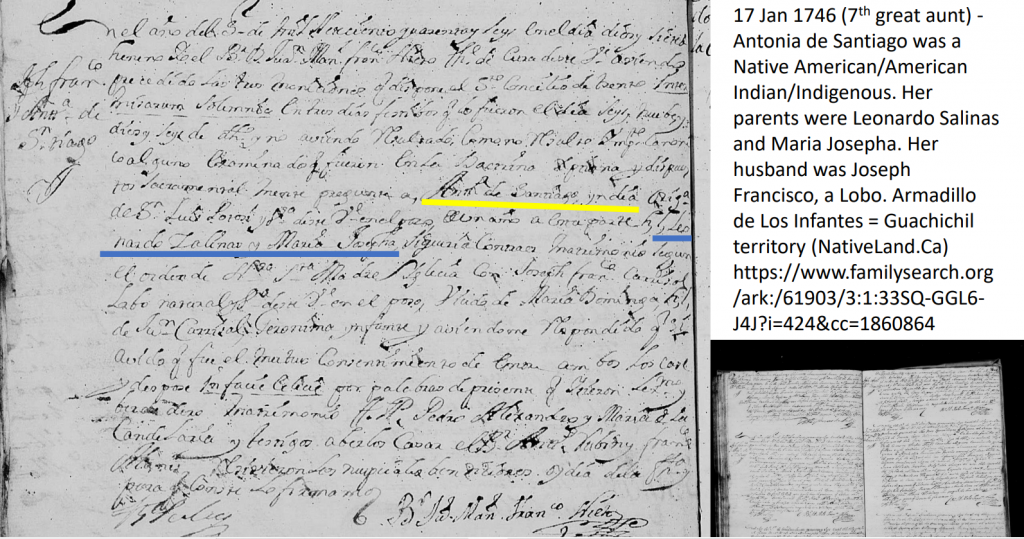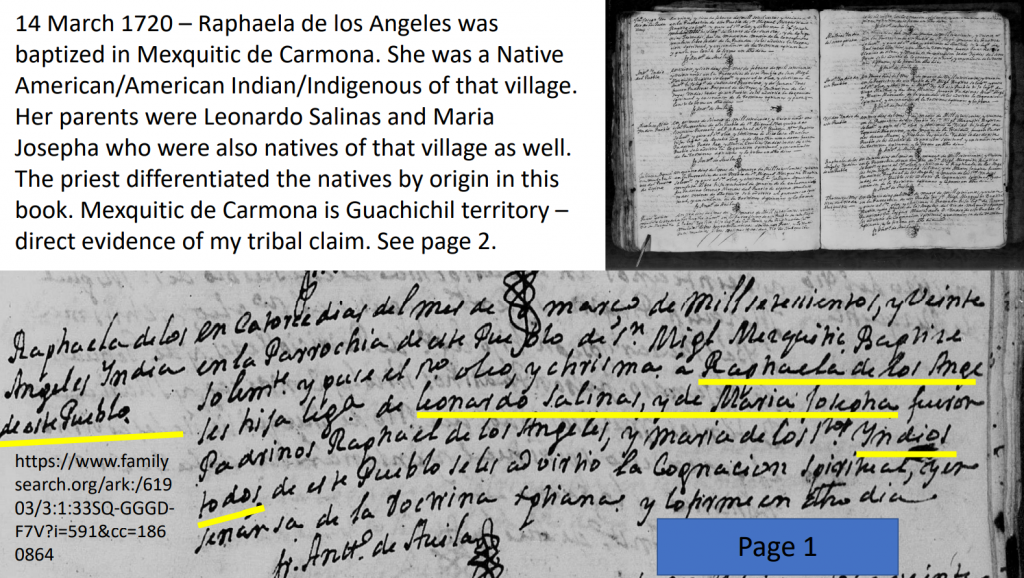Feature: How I Found 39 Native Ancestors in 6 Months – Genealogy Fundamentals
By Juan Zapata
03/01/2021
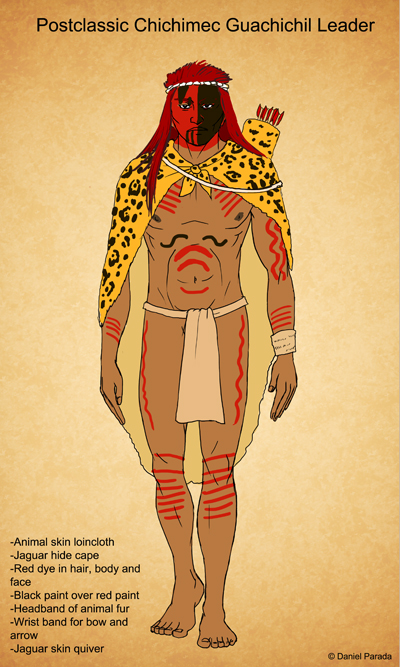
What I have to teach is nothing new, nothing groundbreaking, and nothing overly complicated. I am also far from a pro at genealogy but perhaps what I have to advise will come in handy. How did I get this far? Some luck as a lot of my ancestors were indexed in records; however, finding the indexed records is part of the puzzle. I will walk you through my OCD style of running ancestors through genealogy search engines, the details I always check, and my own personal tips and tricks, so here goes, buckaroo.
*purchases made are at an individuals risk, we are not liable for interactions with any DNA providers mentioned in the article; do your research before purchase
First, you will need to develop the Mangekyou Sharingan to be able to read the Spanish cursive.
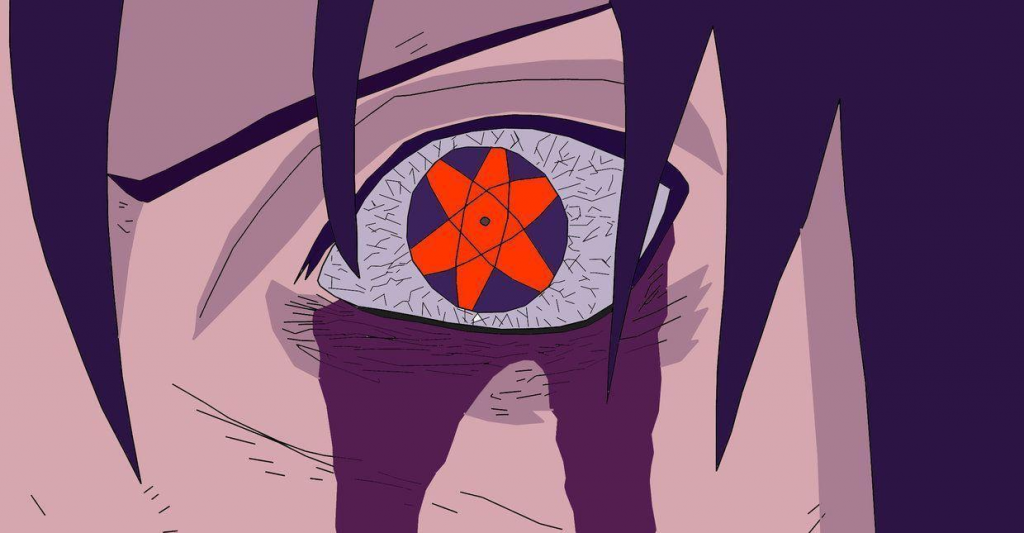
This will be quite a challenge all on it’s own and involves taking the life of your best friend – I’m kidding. When I first started I didn’t know how to read Spanish cursive, but I did know how to read Spanish, so that helped, but it was a large learning curve to adapt Spanish written in cursive. The way I gained this occult ability is by staring at the squiggly lines forever until they began to form words and make sense. It took dozens of hours of dedication, but it worked. I would also reference English cursive charts a few times.
We will explore how I found my ties to the Guachichil tribe through my 7th great grandparents in a baptism record from 1720 of my 7th great aunt, Raphaela de los Angeles. This will also be available in a video format to help with understanding/retention.
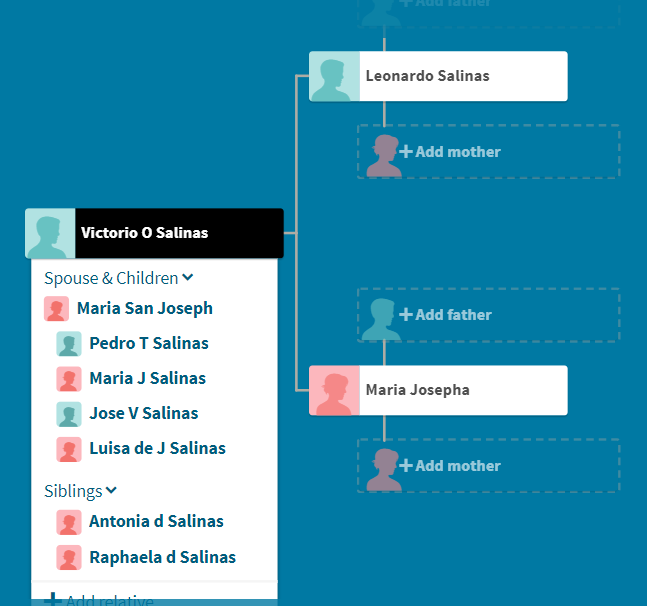
Tips and Tricks for Family Search
In today’s walkthrough we’ll be using Family Search, which is a free genealogy website run by Mormons. It is very user-friendly and the best for running ancestors and obtaining records. Most of my findings came from this website, although a significant portion also came from AncestryDNA’s website that I highly recommend. I also highly recommend purchasing a DNA test from AncestryDNA for those most interested in their native ancestry.
The reason is because they have millions of user-submitted DNA to compare to, they’ve been around a long time, and they’re extremely accurate with their percentages. I will revisit the DNA topic at the end with pictures of my DNA tests and how AncestryDNA compares against Crigenetics, MyHeritage, FamilyTreeDNA, and SomosAncestria. I haven’t tried 23andme, but I’ve noticed they are more apt to undercut a person’s native percentages and AncestryDNA does not do this.
Alright, let’s go to the Family Search Records section: https://www.familysearch.org/search/

We’ll run a basic search with the ancestor in question. Nothing too fancy, yet. In this example, we will assume we already knew the names of Victorio Obispo and his wife Maria Josepha, my 6th great grandparents. First, we are looking for a marriage record through Victorio Obispo Salinas’ name. If nothing relevant pops up, we will proceed by adding Victorio Obispo’s wife, Maria Josepha to the search run. If that doesn’t work, we can add the following one by one until we get some relevant results:
- add a state in addition to the wife.
- add a possible death date or birth date range for either of them to help sift out unwanted records.
The key is not to give up, but keep adjusting our strategy. Start basic, then add strands of information. I’ve noticed adding very specific details from the beginning can result in little to zero results due to how these records are indexed. More than likely they aren’t going to match your information 100% letter by letter, or your ancestors’ 4 different names in the combination you have. I advise against starting out with a full name like Jose Victorio Obispo Salinas right away. By starting simple with just Victorio Salinas, for example, or whatever 2 names you feel are the most pertinent we are able to get some results and start narrowing it down from there.
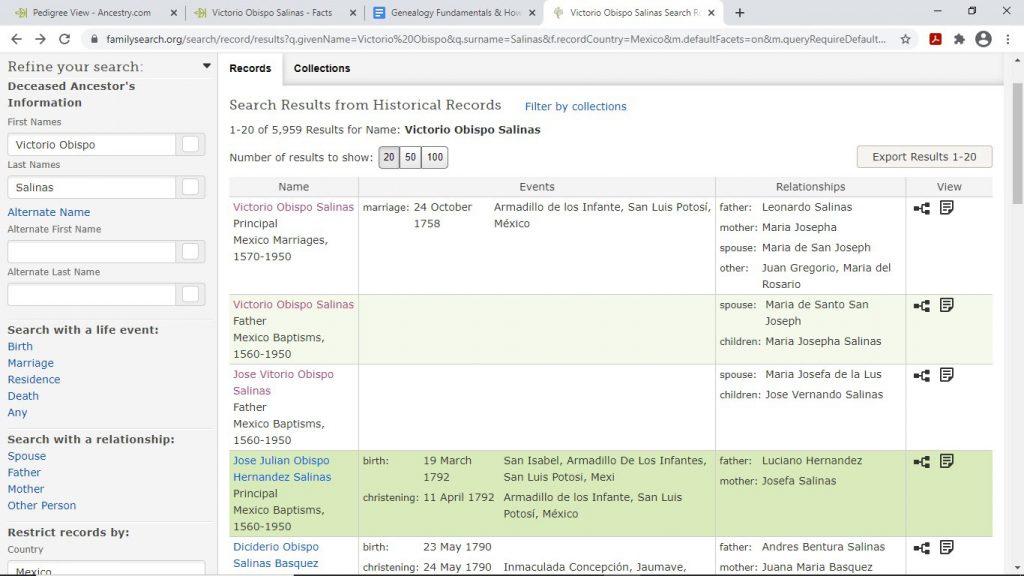
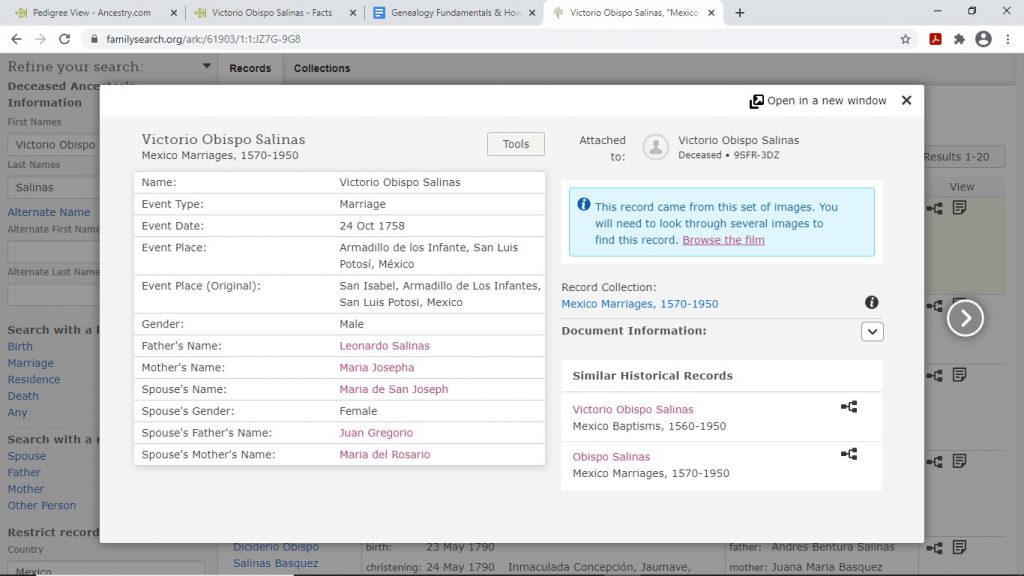
Foreign Family Trees
When I click on the record, there are several avenues I can take to make the most out of my time. On the bottom right, you see “Similar Historical Records”. This is a treasure trove as other family members can be discovered through this and will allow you to make a breakthrough and go farther but we will get into that. One easy cheat-code before going down the rabbit hole of “Similar Historical Records” is to check the top right for the “Attached To” section. Through this “Attached To” section it is possible to find your ancestors in someone else’s tree. If you do, DO NOT immediately add everything they have, but rather go through their records and evidence to confirm that they got to your ancestor and past him/her through sound genealogy. If you cannot pinpoint any valid ties such as a baptismal record for your ancestor linking them to their grandparents and their parents have no records linking themselves to their own parents, keep an eye out for sibling records. This could help you bridge the gap. What do I mean? For example, let’s say you have an ancestor named Pedro Gonzalez. The father is Marco Gonzalez. The tree has the father of Marco Gonzalez on there, Rubio Gonzalez who is Pedro’s grandfather. The issue is that you only have a marriage certificate for Pedro Gonzalaz and you have no marriage record or baptismal record for Marco Gonzalez where Rubio Gonzalez is mentioned. You have now hit a wall. How in the world did the other genealogist get Rubio’s name or figure out that Rubio is Pedro’s grandfather? We could try to check the siblings’ records for Pedro Gonzalez. In this hypothetical scenario, Pedro has a sibling named Graciela Gonzalez; the genealogist found her baptismal record and her baptismal record lists Marco Gonzalez as the father AND Rubio Gonzalez as the paternal grandfather. Connection complete. I ran into this scenario countless times and using siblings’ records was a great way to establish legitimate connections and continue further up the tree. It can be a quick victory when searching for native ancestors and adding them to your collection or español ancestors if you’re searching for them.Revisiting the “Attached To” option, it will bring you to the profile screen for the subject on FamilySearch. If you want a wide view of how far back the other genealogist got, just click the “View Tree” option at the top right.
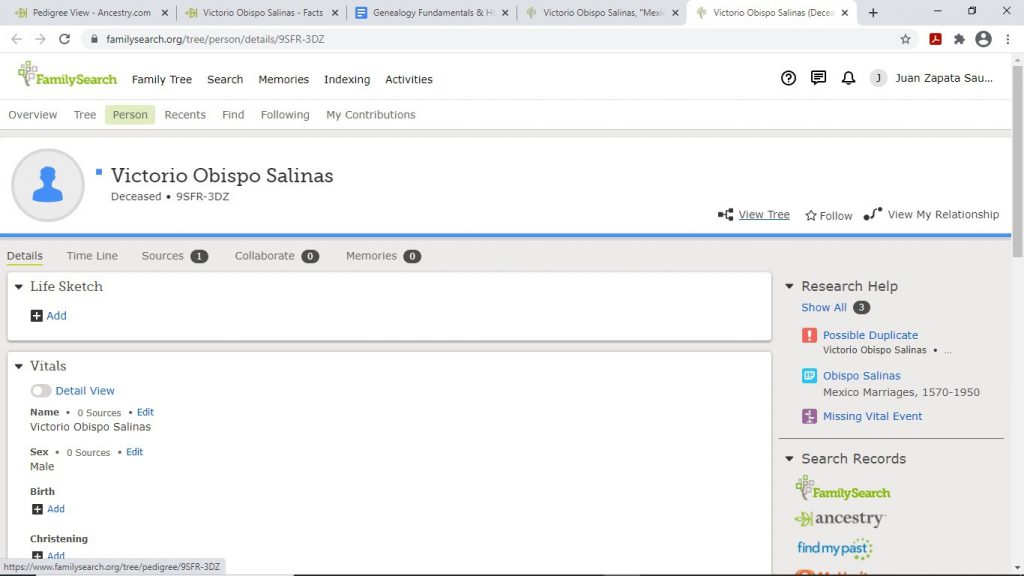
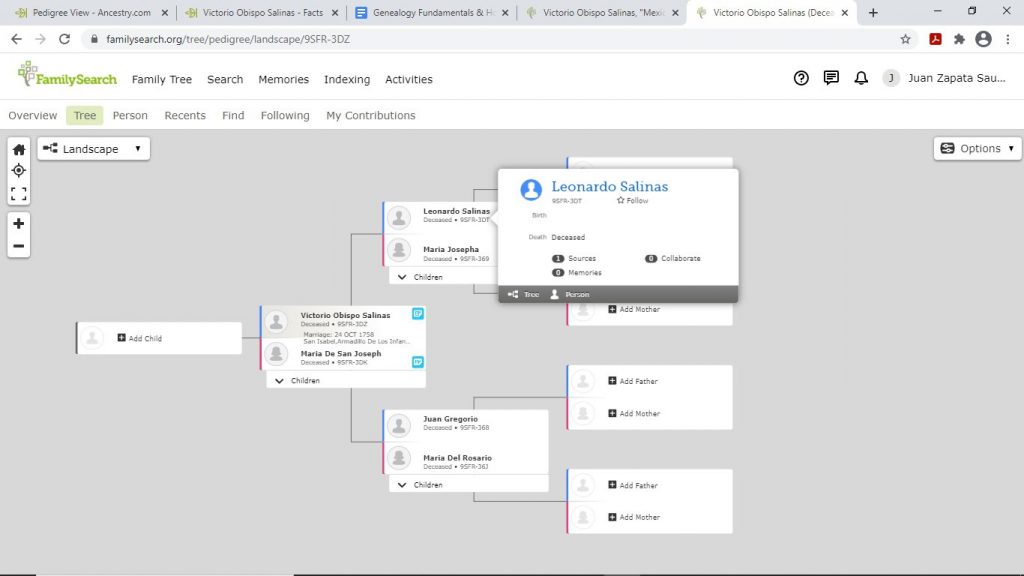
The blue label at the top right of every name box are hints plus other records that may reference that person. Feel free to explore those to get back farther. The other genealogist may not have thoroughly reviewed them or added them to the tree.
Let’s go back to the profile page, you can scroll to the bottom and see a more grounded diagram of family with the siblings available to sift through.

In this case, Leonardo Salinas and Maria Josepha don’t have any additional children listed in this tree. I have already done the genealogy so I know that they do have more, but it isn’t listed on this tree. I found them through the “Related Records” section from the beginning section in this article which we will revisit.
Let’s return to the main page for the record we are currently examining. On the bottom right, as mentioned before, you will find related records.

AncestryDNA Genealogy Tools
AncestryDNA partnered with FamilySearch, so many of the records they have on there are from the first website we’ve discussed. However, there are some indexed records FamilySearch does not have that are on Ancestry’s site. That is another reason I recommend getting tested with Ancestry – so you can take advantage of this. AncestryDNA is where I primarily have my family tree and actively add to it. The $40 a month membership has been worth it to me. To get to a person’s profile page on your family tree, click on their name from the pedigree view. You’ll see something like this page come up.
When you start your tree you should add as much information as you can to an ancestor such as their spouse, children, birth dates, death dates, etc. Adding any of those connections from the outset will be very advantageous because hints will pop up in the hints section which you can review. Hints can lead to you discovering additional children of that person, marriage records, parents, etc. – the possibilities are endless on what variations you can learn. The more records you find that pertain to that person, the more hints that may continue to pop up. Adding hints is fairly easy – just follow the instructions on AncestryDNA – it’s a friendly user interface. But, let’s say you plug all your information in and have 0 hints appear, here is what you can do.
If you have zero hints pop up, click on the “Search on Ancestry” button.
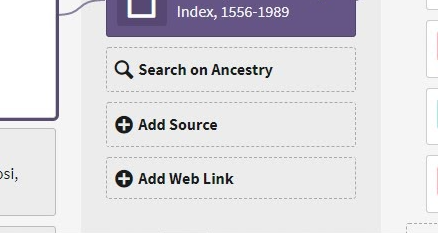
This method will take some time and work, but it will pay off. You’ll need to have some patience as AncestryDNA’s search engine can be funky like FamilySearch’s engine.
My advice on this is to hover your mouse over the hyperlinked text of each record. In this case it would be “Nuevo Leon, Mexico, Civil Registration Deaths, 1852-1962” and check the names.
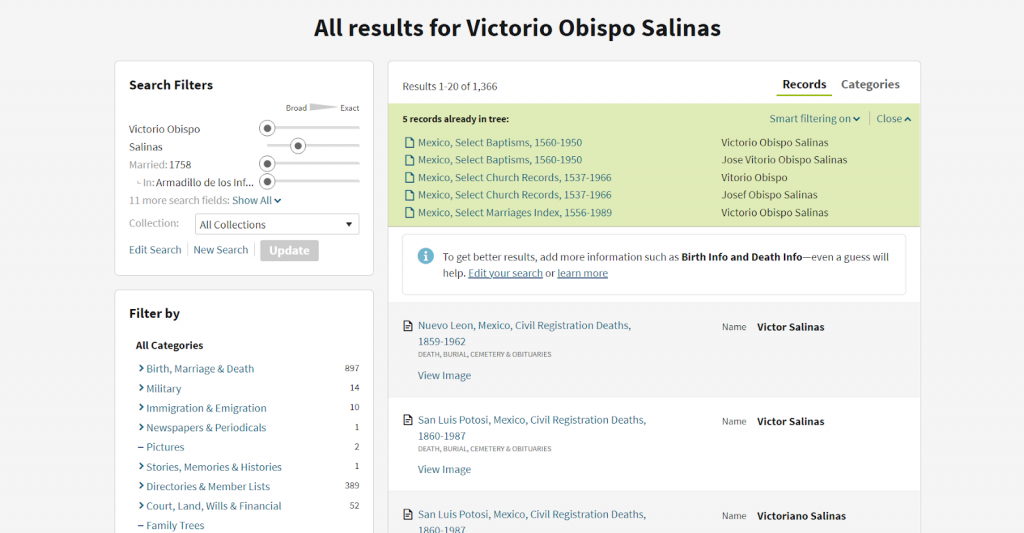
If they align with what you know of your ancestor, click on the record and check it out in depth. If not, move along. Keep scrolling down and check at least 2 pages. The reason for this is that the search engine acts weird on AncestryDNA. Something that is attributable to your ancestor may not be at the top but rather at the very bottom of the results, so take your time. Let’s examine a record I found.
Here I found a daughter of Victorio Obispo Salinas. I saved the record to my profile. Once I did this, I was able to click on “View Record” and get a date as well as a film number. I’ll show you what that looks like but before we proceed let’s take note of the “Suggested Records” section. This can be a gold mine just like the “Similar Historical Records” on FamilySearch. Be sure to look for consistency to be safe before adding anything.
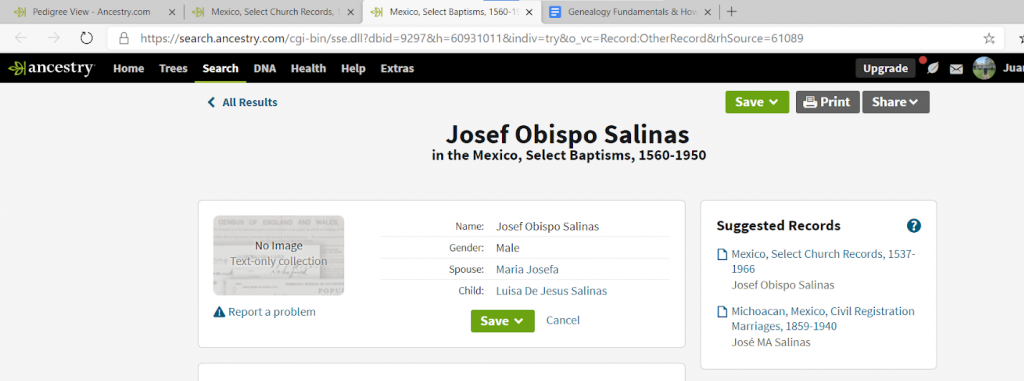
If the names differ way too much from your ancestor’s name, that can be a red flag. For example, I have mine down as Jose Victorio Obispo Salinas, but the record says Joseph Victorio Obispo, so that’s okay – the names are essentially the same. But if you have an ancestor that is Maria Josepha and the name appears as “Josefa de la Luz” you’ll need to be wary and really scrutinize it. Ancestors’ names change slightly at times from record to record. Another area to spot for consistency is the church. If these name changes are happening around the same time at the same church in the same location, the record is pretty safe to run with. Chances are very high it is your ancestor.
In this example, I have a related record for “Jose Maria Salinas” in Michoacan which already gives off a red flag. All the other records I added were for slight variations of the same name “Victorio Obispo Salinas” in the location Armadillo de Los Infantes, San Luis Potosi. The related record in Michoacan is not going to be associated with my ancestor, so I will ignore it and move on. The same principles of searching apply here as on FamilySearch minus the Foreign Family Tree option. Other trees can come up, but that will pop up in the hint section, not here. Be sure to click on every single hyperlinked name on the record to check for more related records for every ancestor.
I went back to Victorio Obispo Salinas’s main profile, clicked on the record, and then on View. This popped up.
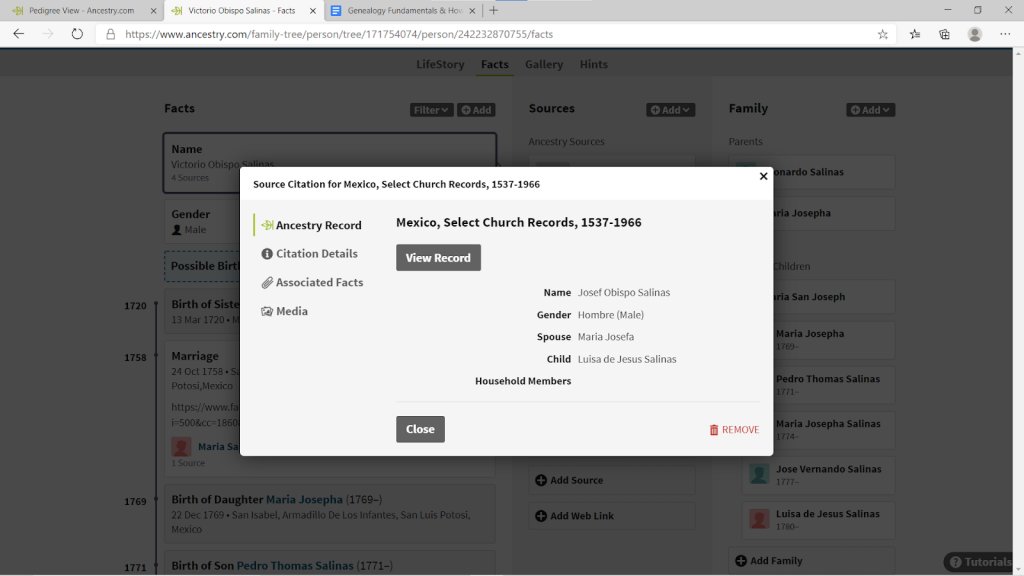
No additional information is available beyond the very rudimentary details. To access the date and location and perhaps a film number, click on the person that is the main subject of the record and go to their profile. This would be “Luisa de Jesus Salinas.”
I went to Luisa de Jesus Salinas’s profile and viewed the record from her end. This prompted the film number, date, and location to pop up.
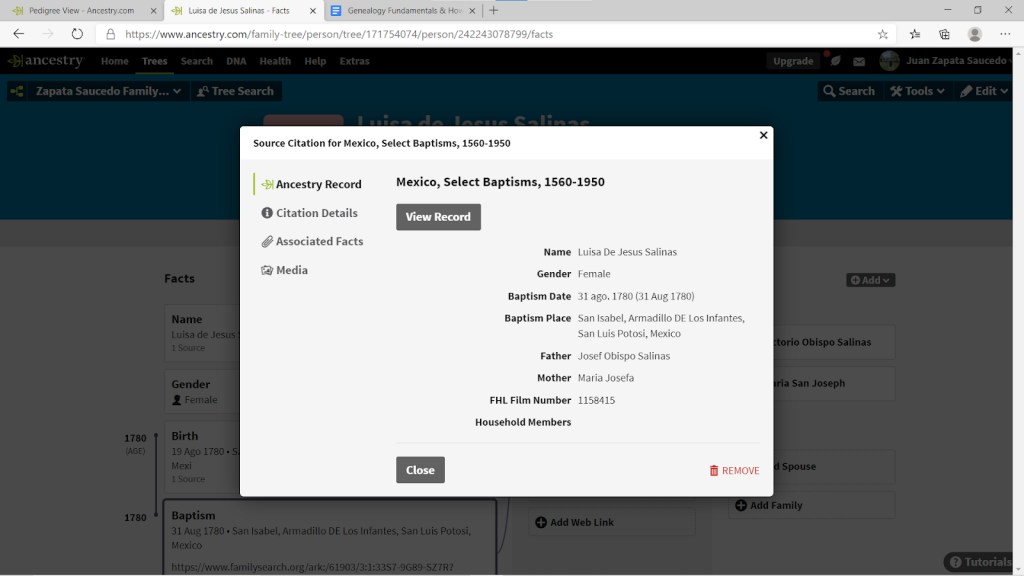
What you can do with the film number is copy it, take it to FamilySearch, and go to the catalog section of Family Search in their drop down menu under “Search”. Paste the film number and hit search. This will take you to the microfilm that houses the record. You’ll have to manually search through it to find the record you are looking for. This will be a page by page search, but it isn’t super bad since you have the date when the event took place.
Look for the film number in the list to begin your search. Once you find it, click on the key and camera to go into the microfilm itself and begin to search for the record you need.
Another trick is to check the profile page for prompted searches like the example here which says “Possible Marriage Records” with the green search button. Click on this link and sift through the records. This might yield a result that the regular search function might not have pulled up. The search algorithms can be unpredictable sometimes, but they can work in your favor.

DNA Tests
As promised, I will show you the differences between 5 DNA tests I have for myself. 2 of them I took, and 3 I uploaded onto the websites’ raw DNA databases to get their ethnicity estimates.- Native American sum 51.30%
- 50% AncestryDNA
- 54.70% Crigenetics
- 68.9% MyHeritage
- 36% FamilyTreeDNA
- 46.39% Somos Ancestria
- European sum 42.98%
- 46% AncestryDNA
- 46.30% Crigenetis
- 24.1% MyHeritage
- 58% FamilyTreeDNA
- 41.14% Somos Ancestria
- Black sum 1.408%
- 2% AncestryDNA
- 0% Crigenetics
- 3.2% MyHeritage
- 0% FamilyTreeDNA
- 1.84% Somos Ancestria
- Asian sum 1% (I’m rounding up in this case since it popped up in two tests)
- 0% AncestryDNA
- 0% Crigenetics
- 1% MyHeritage
- 0% FamilyTreeDNA
- 1% Somos Ancestria
- MENA (Middle Eastern and North African category) sum 3.628%
- 2% AncestryDNA
- 0% Crigenetics
- 3% MyHeritage
- 4% FamilyTreeDNA
- 9.14% Somos Ancestria
- Total Average of 5 while using a MENA category (Middle Eastern and North African)
- 51% Native American
- 43% European
- 1% Black
- 1% Asian
- 4% MENA
Victorio Obispo Salinas to Raphaela de Los Angeles (1720)
Below, I demonstrate in a condensed format how I got my best evidence for claiming the Guachichil tribe. The records I found support each other due to the close proximity of locations, consistent names, and time period. This is from my “Native American Lineage Proof” PDF and is the very last leg of the journey. Raphaela de Los Angeles is my 7th great aunt; she is the sister of Victorio Obispo Salinas. Leonardo Salinas and Maria Josepha are my 7th great grandparents. Judging by how Rapaela was baptized in 1720, Leonardo and Maria likely were 15-20 years of age when they had her, so they probably were born in between 1700 and 1705. This is my oldest indigenous record.
Overall Summary of My Guachichil Tribal Claim – Statement of Evidence
I have 37 indigenous ancestors I have found in Guachichil territory. They come from the areas of
- Mazapil, Zacatecas
- Armadillo de Los Infantes, San Luis Potosi
- Mexquitic de Carmona, San Luis Potosi
- Bocas, San Luis Potosi
- Venaditos, San Luis Potosi
- Venado, San Luis Potosi
- Patos, Coahuila
- General Cepeda, Coahuila
Primarily, Armadillo de Los Infantes and Mexquitic de Carmona are known to have been smaller towns pertaining heavily to Guachichiles. I have two ancestors that are clearly stated to be of Armadillo de Los Infantes: Joseph Esteban 1751 (indio) & Maria de la Concepcion 1741 (india). Though, it should be mentioned the vast bulk of my ancestors were baptized/married in Armadillo de Los Infantes. They come from “Venaditos”; Venaditos is a town in the municipality of Iturbide, present day Villa de Hidalgo, SLP – also almost exclusively Guachichil territory. Before that, some came from Norias del Vallejo/El Pozo; Norias del Vallejo is a town in the municipality of Guadalupe, cut from Catorce in SLP, deep in Guachichil territory (Diccionario Geografico by Garcia Cubas Volumes 4-5). The territories of Venado, General Cepeda, Bocas, & Patos were all Guachichil territory as well.
My strongest evidence for my tribal claim is my 7th great aunt, Raphaela de Los Angeles, in her baptismal record of 1720. There it lists her and my 7th great grandparents, Leonardo Salinas & Maria Josepha, as natives of the village of Mexquitic de Carmona. Tlaxcalans were brought 100 years before that to live alongside the Guachichiles there; however, it is very probable there was significant mixing. Nevertheless, in this particular book, the priest differentiated the natives based off of origin; my ancestors were clearly emphasized to belong to that specific village. This indexed record popped up as a related record to Antonia de Santiago, my 7th great aunt’s marriage record in 1746, & my 6th great grandparents’ marriage record of 1758 – both of aforementioned events taking place in Armadillo de Los Infantes.
Additionally, a book titled Guachichiles & Franciscanos by Lucas Martinez Sanchez, talks of a group of Guachichiles called “of the Salinas”. This area is in what today is known as “Salinas de Hidalgo, San Luis Potosi”. The significance is that many of my ancestors have the Salinas as their last name, supporting my tribal claim (https://www.seducoahuila.gob.mx/colegiocoahuilense/assets/4.-guachichiles-pdf.pdf).
Finally, in my genealogical research, I have found over 100 ancestors (not counting the siblings of direct ancestors) I have not been able to identify with a caste label from before 1850 (various have the mestizo label, but this will often yield indios further back); these ancestors are from Guachichil territory.
With the above laid out, I, henceforth, title myself with the name “Juancholoa” –an authentic Guachichil name from the above source.
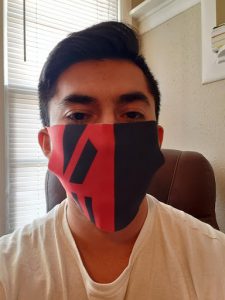
Check out the other two articles I’ve written about my Indigenous journey:

